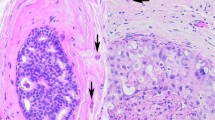Abstract
A detailed analysis of the consistency with which pathologists from 12 different European countries diagnose and classify breast disease was undertaken as part of the quality assurance programme of the European Breast Screening Pilot Network funded by the Europe against Cancer Programme. Altogether 107 cases were examined by 23 pathologists in 4 rounds. Kappa (κ) statistics for major diagnostic categories were: benign (not otherwise specified) 0.74, atypical ductal hyperplasia (ADH) 0.27, ductal carcinoma in situ (DCIS) 0.87 and invasive carcinoma 0.94. ADH was the majority diagnosis in only 2 cases but was diagnosed by at least 2 participants in another 14, in 9 of which the majority diagnosis was benign (explaining the relatively low κ for this category), DCIS in 4 (all low nuclear grade) and invasive carcinoma (a solitary 1-mm focus) in 1. The histological features of these cases were extremely variable; although one feature that nearly all shared was the presence of cells with small, uniform, hyperchromatic nuclei and a high nucleo-cytoplasmic ratio. The majority diagnosis was DCIS in 33 cases; κ for classifying by nuclear grade was 0.38 using three categories and 0.46 when only two (high and other) were used. When ADH was included with low nuclear grade DCIS there was only a slight improvement in κ. Size measurement of DCIS was less consistent than that of invasive carcinoma.The majority diagnosis was invasive carcinoma in 57 cases, the size of the majority being 100% in 49. The remainder were either special subtypes (adenoid cystic, tubular, colloid, secretory, ductal/medullary) or possible microinvasive carcinomas. Subtyping was most consistent for mucinous (κ, 0.92) and least consistent for medullary carcinomas (κ, 0.56). Consistency of grading using the Nottingham method was moderate (κ=0.53) and consistency of diagnosing vascular invasion, fair (κ=0.38). There was no tendency for consistency to improve from one round to the next, suggesting that further improvements are unlikely without changes in guidelines or methodology.
Similar content being viewed by others
Author information
Authors and Affiliations
Consortia
Rights and permissions
About this article
Cite this article
Sloane, J., Amendoeira, I., Apostolikas, N. et al. Consistency achieved by 23 European pathologists from 12 countries in diagnosing breast disease and reporting prognostic features of carcinomas. Virchows Archiv 434, 3–10 (1999). https://doi.org/10.1007/s004280050297
Issue Date:
DOI: https://doi.org/10.1007/s004280050297




